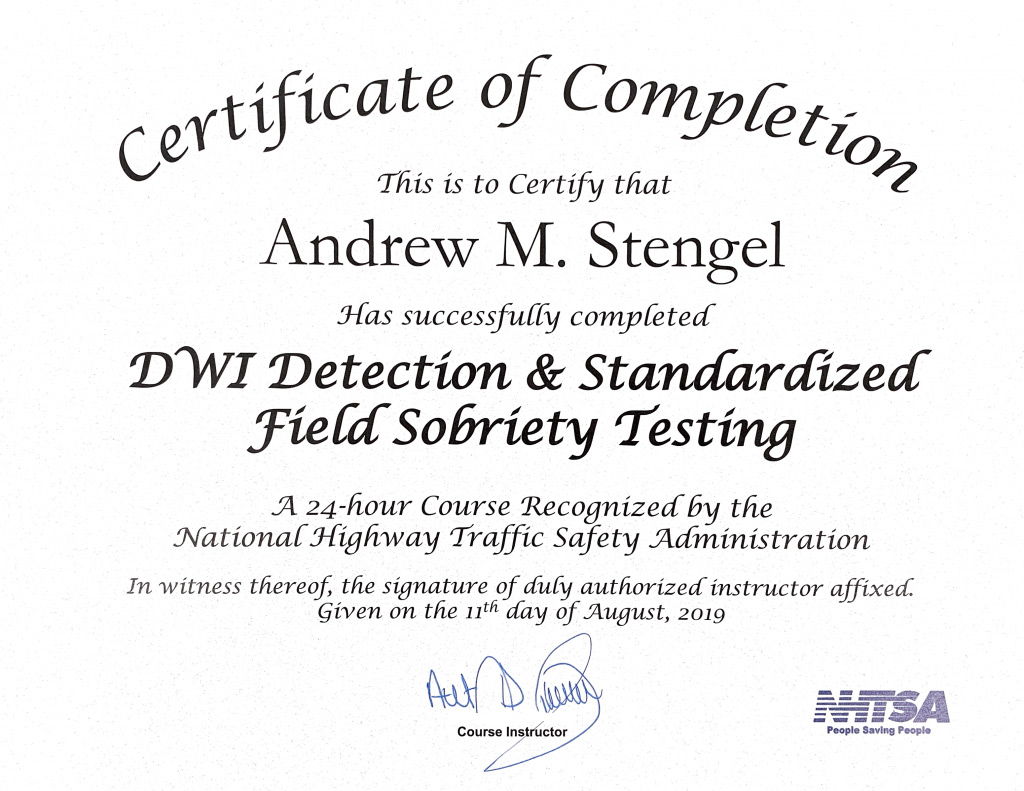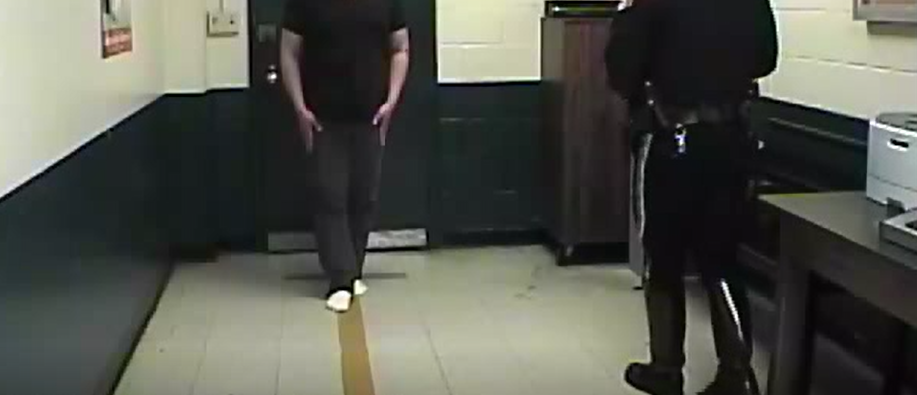DWI Field Sobriety Tests: NYPD Coordination Tests
The primary field sobriety test employed by the New York City Police Department (NYPD) following stops for suspicion of Driving While Intoxicated (DWI) or Driving While Ability Impaired by Drugs is a non-standardized test. The NYPD’s field sobriety test for DWI, which the NYPD often refers to as coordination tests, are actually three separate tests: walk and turn, the one-leg stand and finger to nose. These DWI coordination tests are video recorded by the NYPD and used as evidence in the prosecution.

Andrew M. Stengel is trained the same way as police to perform DWI Standardized Field Sobriety Tests.
The NYPD’s DWI coordination tests stand are somewhat different from standardized DWI field sobriety tests, which are often performed by police outside of New York City. The standardized DWI field sobriety test, which has much in common with the NYPD’s DWI coordination tests, were developed by the National Highway Traffic Safety Administration and require a minimum of 24 hours of training in order to be certified to administer them. There are some police officers in the NYPD who are trained in administering the standardized test and at times will perform the horizontal gaze nystagmus test on a person who has been stopped for suspicion of DWI.
Unlike a refusal to submit to a chemical test like a breathalyzer, there are no direct legal consequences for one’s refusal to take to field sobriety tests. In New York, a breathalyzer refusal results in a driver’s license revocation for 1 year and under certain circumstances the refusal can be used at trial of consciousness of guilt, i.e., a person refused because they knew that they were intoxicated. These penalties do not apply to DWI sobriety test refusals. Whether or not to agree to take the NYPD’s coordination test is a highly fact specific question. If stopped for DWI a person should try to reach a lawyer before agreeing to take a DWI chemical test or field sobriety tests.
The results of field sobriety tests, whether standardized or non- standardized, are highly subjective. An experienced DWI defense attorney can often attack poor results of a DWI coordination tests. Most DWI stops occur late at night or in the early hours of the morning. Imagine the shock of being detained at such an hour if you have never before been in trouble with the law. You are brought to a police precinct while handcuffed in the back of a patrol car. You are taken to a room, a video camera is turned on and asked to take a breathalyzer and to perform “simple test for physical coordination.” A police officer barks instructions for three separate sobriety tests, which when heard for the first time seem strange. Then you are told to perform the test exactly as instructed without any practice or a do-over. It may not be surprising if a police officer believes that you performed poorly, whether or not you are legally intoxicated. In addition, what a police officer grades as a poor performance on official paperwork may not actually be so.
In New York City the DWI coordination tests will given in the following order by the NYPD.
Walk and Turn DWI Coordination Test
Before the walk and turn test is given, police will ask a person to assume a heel to toe stance before the instructions are given. The object of the test is to take 18 steps, 9 in one direction and 9 in the opposite direction while walking on marked straight line on the floor, with a turn using only one foot in between.
Police give the following instructions for the walk and turn test:
- Place your left foot on the line
- Place your right foot on the line ahead of the left foot, with the heel of the right foot against the toe of the left foot
- Place your arms down at your side
- Keep your position until I tell you to begin. Do not start to walk before told to do so
- Do you understand the instructions so far?
Generally, a person taking the test will stand against the door to the room, which may feature vertical line. Although standing still with a person’s heel and toe touching is not a DWI test per se, movement to either side may be apparent relative to the vertical line. Remember: the NYPD video records the coordination tests.
The next set of instructions are usually demonstrated by a police officer:
- When I tell you to start, take 9 heel-to-toe steps turn and take 9 heel-to-toe steps back
- When you turn, keep the front foot on the line, and turn by taking a series of small steps with the other foot
- While you are walking, keep your arms at your side, watch your feet at all times and count your steps out loud
- Once you start walking, do not stop until you have completed the test
- Do you understand the instructions?
If a person acknowledges that he or she understands, then they will be told to begin and count the first step as one. A test subject will be graded as steady, unsteady, falling or other. In addition, police may make notes for any instruction that are not followed. For example, begins too soon, arms not at sides, walked off line and did not count out loud, to name only a few.
One-Leg Stand DWI Coordination Test

Similar to the walk and turn test, a police officer will give verbal instructions followed by a demonstration. The goal of the test is to keep one’s foot raised about 6 inches off of the ground for about 30 seconds.
The NYPD gives the following instructions before the one-leg stand test:
- Stand with your feet together and arms down at your sides
- Do not start the test until I tell you to do so
After asking if the test subject asks the instructions, the police officer will demonstrate the following:
- When I tell you to start raise one leg, either leg, approximately six inches off the ground with the foot pointed
- You must keep both legs straight, arms at your side
- While holding the position, count out loud: one thousand one, one thousand two, one thousand three and so on
- Keep your arms at your sides at all times and keep watching the raised foot
After asking the subject if they understand the instructions, the police officer will say to begin the test. Although it is not explained by a police officer in the instructions, the NYPD allows the one-leg stand test to continue for 30 seconds. A subject will be graded as steady, unsteady, falling or other. In addition, police may make notes for any instruction that are not followed. For example, puts foot down, lifts arms, does not count out loud, to name only a few.
Finger to Nose DWI Coordination Test
The third and final non-standardized field sobriety tests given by the NYPD is the finger to nose test. The test is perfumed with one’s eyes closed and their head tilted back. The test requires a person to touch the tip of their nose with the tip of their index finger 6 times.
The following instructions are given before a demonstration:
- Put your feet together and stand straight
- Place your arms down at your sides
- Close your hand and extend your index finger
The following instructions are demonstrated by the NYPD:
- When you are told to begin, tilt your head back and close your eyes
- Bring the tip of your index finger up to the tip of your nose
A final set of instructions is given usually without a demonstration:
- As soon as you touch your finger to your nose, return your arm to your side
- When I say right, move your right hand index finger to your nose
- When I say left, move your left hand index finger to your nose
Once a person is told to begin the police officer will make sure that the subject’s head is tilted back, they return their hands to tither sides after each attempt and their eyes closed until told to open them. The commands are given in the following sequence with a 2- or 3-second pause in between: LEFT, RIGHT, LEFT, RIGHT, RIGHT, LEFT.
A subject will be graded as accurate or inaccurate with the left and right hands. In addition, police may take note if a person does not keep their eyes closed, head back and doesn’t return their arm to their side.





